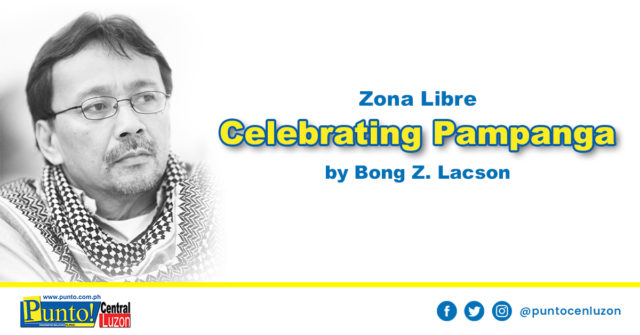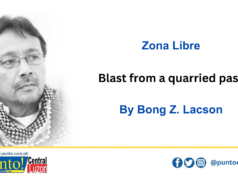MANGAN TAMU – let us eat in the Mequeni language – has opened at the Clark Freeport offering the widest variety of Capampangan gustatory delights. It is the latest celebration of the best that the province can offer.
Indeed, Pampanga has long been celebrated – and still is – as Culinary Capital of the Philippines. Food though is but – to me – one of the three things that not only celebrate but verily define the Capampangan.
At this, surfaced anew a book-in-mind conceived seven years ago but has remained in gestation.
SUB-HEADED: Faith. Food. Fiesta. It’s a dream – grand, but hopefully, unimpossible – of encapsulating the Kapampangan character, if not the very soul, in a coffee table book.
Faith. Sermons in stone, searing the heart, stirring the soul. So, we wrote of the churches in Pampanga in an accompanying verse to our photo exhibit Visita Iglesia in March 2012.
As much as edifices of faith, our centuriesold churches have become tourist attractions with the grandiosity of their façades, with the magnificence of their retablos, evoking in the beholder the grandest cathedrals of Europe.
It was in 1572 that the Augustinian friars planted the faith in Lubao, spreading throughout the province and up and across the expanse of the central and northern regions of Luzon.
Consecrated to St. Augustine, the Lubao parish church though damaged in the last war and in some calamities has been restored to its old glory and assumes its place among the socalled legacy churches of Pampanga.
Two of these old churches have been declared by the National Museum as National Cultural Treasures — the Sta. Monica Parish Church in Minalin in August 2011, and the St. James the Apostle Parish Church in Betis, Guagua in November 2001.
The other “churches of antiquity” attracting pilgrims and tourists alike are the Holy Rosary in Angeles City; Sta. Lucia in Sasmuan; Sta. Rita in Sta. Rita; San Guillermo in Bacolor; San Luis Gonzaga in San Luis; St. Peter the Apostle in Apalit; San Bartolome in Magalang; and the Metropolitan Cathedral in the City of San Fernando.
A brief essay on the churches – to be penned by Lord Francis Musni, foremost Kapampangan scholar on the subject – will make the most appropriate introduction to the Faith section of the book.
Food. Pampanga prides itself as the culinary capital of the Philippines. There’s just some ingredient in the Kapampangan food that distinguishes it from any other in the country, be it from the Spanish heirloom recipes for morcon and galantina to the exotic adobong camaru, betute, sisig and binulo to the ambrosiac buro.
Already, the mouth waters at the mere thought of these dishes, how much more with the photographs of Peter Alagos and Deng Pangilinan illustrative of a most delectable essay from Robbie Tantingco!
Fiesta. The resultant mix of faith and food. Of all the provinces, arguably, Pampanga has the most towns, barrios and sitios named after saints, not to mention subdivisions and housing developments.
feast days of the saints make joyous celebrations of thanksgiving – for good harvests, for salvation from calamities – and cause for homecomings and family reunions, necessitating grand banquets, that usually last for days – from the start of novenas, to ante-vesperas, to the day of the fiesta itself.
From there evolved festivals that celebrate each the town’s peculiarity or product.
Thus, the Giant Lantern Festival in the City of San Fernando – and the Tugak Festival and Good Friday crucifi xion rites too; the Ibon-Ebon in Candaba; Duman and Suman in Sta. Rita; Sampaguita in Lubao; Aguman Sandok in Minalin; Caragan in Mabalacat; Tigtigan, Terakan King Dalan and Sisig Festival in Angeles City.
Religious-themed festivals have remained though in Apalit with the fluvial procession on St. Peter’s feast day; Sabuaga honouring the Virgin Mary in Sto. Tomas on Easter Sunday; Kuraldal in Sasmuan on the feast of Sta. Lucia; and Makatapak in Bacolor, as a form of purification in the wake of the devastation wrought on the town by the Mount Pinatubo eruptions.
Faith. Food. Fiesta. Pampanga, but of course, is more than that.
So, I have in mind a separate section for Etcetera, in the language: At Miya-yaliwa Pa.
Eco-Tourism takes principal stage here: the Nabuclod highlands of Floridablanca with the magnificent view all-around. The wetlands of Candaba for bird watching. Majestic Mount Arayat and its cold springs. Mount Arayat. Miyamit Falls in Porac. Haduan Falls in Mabalacat City. Puning Hot Springs in Sapang Bato, Angeles City.
There. Celebrating Pampanga: Faith. Food. Fiesta. More than an interesting read, it is a journey through the Kapampangan character.
Time to look for some kind Kapampangan souls to make the project roll.
AND I am still looking, and hoping.





